Roy Westwater, one of FCG’s long-standing members, has donated the cost of one of our new ‘perch benches’ on the banks of the Rife in memory of his late wife Barbara.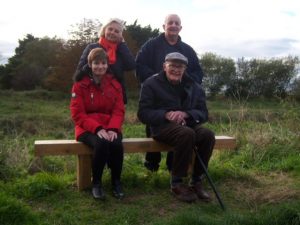 We were pleased to have a suitable plaque engraved and mounted on the bench, and to take this photograph of Roy and members of his family being among the first to use it.
We were pleased to have a suitable plaque engraved and mounted on the bench, and to take this photograph of Roy and members of his family being among the first to use it.
Monthly Archives: October 2021
Fungi Foray 2021
A dozen Ferring Conservation Group members met up recently at the RSPB
Pulborough Brooks reserve for a fungi foray, led by Group committee member Tricia Hall. The wooded area of the reserve is one of the best locally to view a wide variety of fungi at this time of year. The RSPB have marked out a “Fascinating Fungi” trail there, with information notices throughout the woods highlighting the various types to be seen in each location.
The first fungi seen by the Group was right on the boundary of the car park itself where there were a number of specimens of the iconic Fly Agaric – with the well-known red and white spotted cap.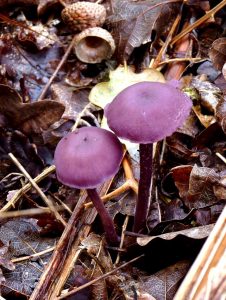 On moving down into the low lying and damp Black Wood area, a whole variety of further types were found, some of which have fascinating names including Amethyst Deceiver (a beautiful purple mushroom amongst the leaf litter), Common Earthball (quite numerous and which smell of rubber if broken open) and Turkeytail (a bracket fungus growing on tree stumps and research into this may result in its use in cancer treatment).
On moving down into the low lying and damp Black Wood area, a whole variety of further types were found, some of which have fascinating names including Amethyst Deceiver (a beautiful purple mushroom amongst the leaf litter), Common Earthball (quite numerous and which smell of rubber if broken open) and Turkeytail (a bracket fungus growing on tree stumps and research into this may result in its use in cancer treatment).
All of this searching was carried out to the background of birdsong from within the trees, and the visit was ended at the view point of Hail’s View overlooking the brooks, where there were distant views of various geese and swans, with two Marsh Harriers hunting over the reeds and vegetation, and a Kestrel hovering overhead.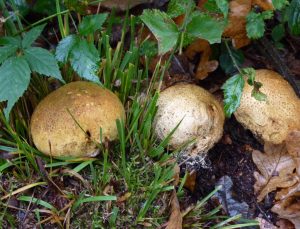
A visit to the reserve is recommended at any time, but an Autumn trip to see the fungi is an added bonus.
2021 Christmas Cards are now on Sale
‘The Great British Rake Off’
After a fallow year in 2020 due to Covid restrictions, volunteers from Ferring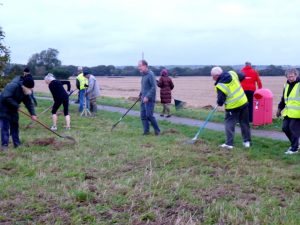 Conservation Group came together again with those from The Good Gym Worthing to rake up the cut vegetation at the foot of Sea Lane Ferring at the start of the month.
Conservation Group came together again with those from The Good Gym Worthing to rake up the cut vegetation at the foot of Sea Lane Ferring at the start of the month.
The Good Gym is a charity with branches across the country where groups of runners combine regular exercise with helping local communities as happened here in Ferring. The reason for the work was to remove the thatch of grass that would otherwise swamp the wild flowers on the verge, which include the attractive Salsify amongst others, and allow them to thrive in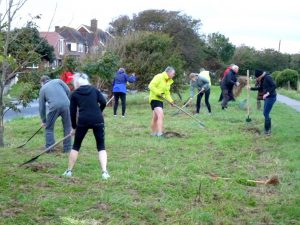 future years.
future years.
About 20 volunteers from both groups met up one tea time, but were greeted by a sudden downpour of rain at the start of the session. Luckily, this soon relented and the task was completed in a friendly way with people mixing well for a chat whilst carrying out the raking. Daylight began to fade, but by then the task was completed.
Ferring Conservation Group Chairman David Bettiss said, “We’re very grateful to our friends from The Good Gym helping us out once again alongside the regular volunteers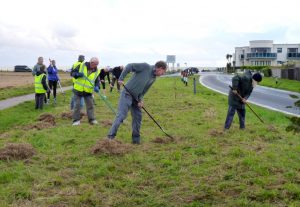 from our own group to carry out this important work. We’ve already seen a definite improvement in the biodiversity here since the annual raking started a few years ago, and trust that next Spring and Summer we’ll all see the fruits of our work with wild flowers blooming. At this time of climate change, it’s critical that we all do our bit to improve our local environment as much as we can, whilst providing a good habitat for our wildlife.”
from our own group to carry out this important work. We’ve already seen a definite improvement in the biodiversity here since the annual raking started a few years ago, and trust that next Spring and Summer we’ll all see the fruits of our work with wild flowers blooming. At this time of climate change, it’s critical that we all do our bit to improve our local environment as much as we can, whilst providing a good habitat for our wildlife.”
The White-tailed Sea Eagle Project on the Isle of Wight
After a gap of nineteen months Ferring Conservation Group were at last able to hold their monthly Group meeting.
To open the meeting project manager Steve Egerton-Read from Forestry England had journeyed over from the beautiful Isle of Wight to give a brief history of the White-tailed Sea Eagles and the latest news regarding the reintroduction of this incredible bird.
Steve began by explaining that the White-tailed Sea Eagle is the UK’s largest bird of prey, with a huge wing span of up to 2.5 metres. The wings are very broad and appear more rectangular than those of a Golden Eagle and as their name suggests they have a white tail, a hooked yellow beak, yellow legs and talons along with piercing golden eyes. They were once widespread along the South Coast of England before being driven to extinction by relentless persecution from the Middle-Ages.
Licences were granted by Natural England and Scottish Natural Heritage to begin an English reintroduction, in partnership with Forestry England, based on the Isle of Wight.
Re-establishing a population on the South Coast will help link populations in Scotland and Ireland with those in the Netherlands and France.
In partnership with the Roy Dennis Wildlife Foundation and Forestry England, this five year programme has reintroduced six young birds that were translocated from nests in parts of Scotland. It is hoped they will eventually help facilitate dispersal of these birds along the South Coast. Before their release the youngsters were cared for by a team of experts with dedicated volunteers spending over 500 hours preparing food etc. Once released these birds will take several years to establish themselves and begin breeding but meanwhile their movements can be tracked remotely via the small transmitters fitted to each bird.
The success of this project will be measured when this magnificent bird is accepted as part of the landscape.
After a short break Ed Miller took to the floor advising members of the many planning applications either recently submitted or awaiting decisions:
Ed advised members that there were 2 applications for a third storey to be added to existing properties; 1 demolition and to rebuild in three storeys and 1 three storey rebuild that had been withdrawn but was likely to return. Also three further partial replacement illuminated signs at Yeoman’s car showroom.
In the Angmering area an application for 191 dwellings at Rustington Golf Centre and 76 dwellings at Roundstone Farm are both awaiting approval. An application by Redrow Homes for an ‘Agricultural’ road in Roundstone Farm has been approved by Arun DC.
The Appeal on the Chatsmore Farm/North Goring Gap development by Persimmon has been registered but with no details as yet on the grounds for the appeal. It was also reported that the Worthing Local Plan is now with HM Inspector for consideration.
Tricia Hall concluded the meeting by updating members on news of local wildlife sightings. Tricia advised members that 28 Egrets had been seen in a field at the back of Kingston Gorse. She suggested that members look in the trees on the west bank of the Rife where several Egrets often roost along with Herons.
Also a number of wading birds have returned including Turnstones, Oyster Catchers, Dunlin and Plover. Although it has been a good year for Dragonflies it has not been the case for Butterflies with only Red Admiral being plentiful and a few Speckled Woods. Tricia had found a pretty Box Tree Moth in her garden. Despite their attractive appearance the caterpillars of this moth have desecrated many Box trees and hedges in the area.
Tricia illustrated her talk with a fascinating photograph of two mating dragonflies and also photographs of her beautiful garden demonstrating how she had created two wildflower beds simply by leaving two areas of her lawn unmown and then scattering a seed mix – she said she was amazed at the number of insects that these attracted.
It was also reassuring to see the high number of wildflowers on Highdown and at Anchor Bottom near Shoreham.

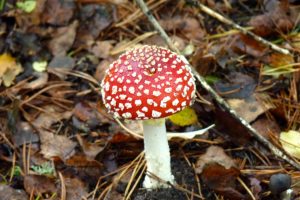
 Please note that our next Group monthly meeting commences at 2.30pm (not 7.30 pm as stated on the poster) Friday 29th October in Ferring Village Hall
Please note that our next Group monthly meeting commences at 2.30pm (not 7.30 pm as stated on the poster) Friday 29th October in Ferring Village Hall